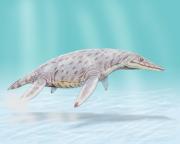Go offline with the Player FM app!
Ancient Giants
Manage episode 408515409 series 63973

In 1983, roadworkers cut a notch in a hillside in Lorraine, a region in northeastern France. Paleontology students examined the exposed layers of rock. They found fossils of an ancient sea creature.
Scientists just recently studied the fossils in detail. They found that the fossils were the remains of a type of giant marine reptile that hadn’t been seen before. It was about 16 feet long, with jaws four feet long. It plied the Tethys Sea, which covered parts of present-day Europe. Because it was discovered in Lorraine, scientists named it Lorrainosaurus.
The creature was a member of a group known as pliosaurs. Earlier research had found that pliosaurs were around at least 165 million years ago. This discovery, along with fossils from another specimen, found in Switzerland, pushed that to about six million years earlier. So pliosaurs appeared near the end of the age of the dinosaurs.
Larger relatives of the pliosaurs began to take over as the top predators in the seas about 175 million years ago. They displaced some giant fish, giant crocodiles, and other big guys. That might have happened because oceans around the world began to cool off about then. The change might have killed the food sources of the previous kings of the sea.
The pliosaurs began to dominate on their own soon after. They remained the top ocean predators for about 80 million years—a long reign for the Lorrainosaurs and their giant cousins as the kings of the sea.
89 episodes
Manage episode 408515409 series 63973

In 1983, roadworkers cut a notch in a hillside in Lorraine, a region in northeastern France. Paleontology students examined the exposed layers of rock. They found fossils of an ancient sea creature.
Scientists just recently studied the fossils in detail. They found that the fossils were the remains of a type of giant marine reptile that hadn’t been seen before. It was about 16 feet long, with jaws four feet long. It plied the Tethys Sea, which covered parts of present-day Europe. Because it was discovered in Lorraine, scientists named it Lorrainosaurus.
The creature was a member of a group known as pliosaurs. Earlier research had found that pliosaurs were around at least 165 million years ago. This discovery, along with fossils from another specimen, found in Switzerland, pushed that to about six million years earlier. So pliosaurs appeared near the end of the age of the dinosaurs.
Larger relatives of the pliosaurs began to take over as the top predators in the seas about 175 million years ago. They displaced some giant fish, giant crocodiles, and other big guys. That might have happened because oceans around the world began to cool off about then. The change might have killed the food sources of the previous kings of the sea.
The pliosaurs began to dominate on their own soon after. They remained the top ocean predators for about 80 million years—a long reign for the Lorrainosaurs and their giant cousins as the kings of the sea.
89 episodes
All episodes
×Welcome to Player FM!
Player FM is scanning the web for high-quality podcasts for you to enjoy right now. It's the best podcast app and works on Android, iPhone, and the web. Signup to sync subscriptions across devices.




